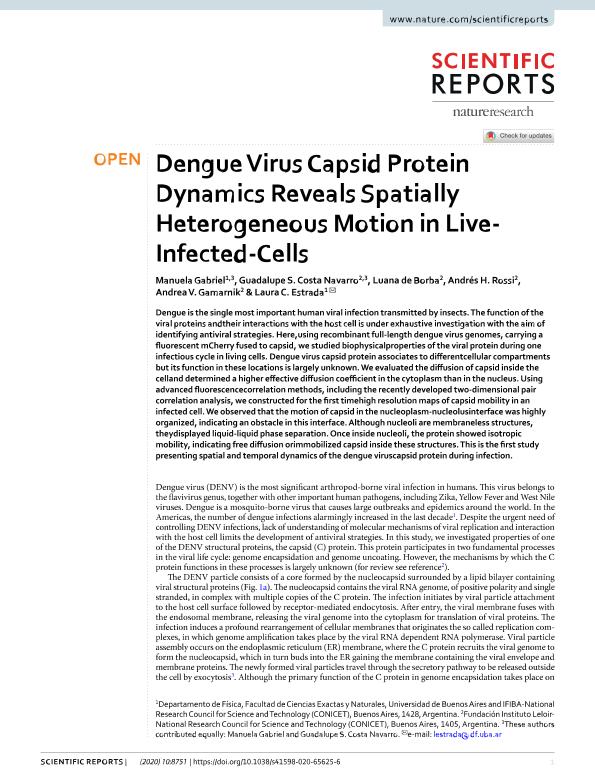Artículo
Dengue Virus Capsid Protein Dynamics Reveals Spatially Heterogeneous Motion in Live-Infected-Cells
Gabriel, Manuela ; Costa Navarro, Guadalupe Soledad
; Costa Navarro, Guadalupe Soledad ; de Borba, Luana
; de Borba, Luana ; Rossi, Andrés Hugo
; Rossi, Andrés Hugo ; Gamarnik, Andrea Vanesa
; Gamarnik, Andrea Vanesa ; Estrada, Laura Cecilia
; Estrada, Laura Cecilia
 ; Costa Navarro, Guadalupe Soledad
; Costa Navarro, Guadalupe Soledad ; de Borba, Luana
; de Borba, Luana ; Rossi, Andrés Hugo
; Rossi, Andrés Hugo ; Gamarnik, Andrea Vanesa
; Gamarnik, Andrea Vanesa ; Estrada, Laura Cecilia
; Estrada, Laura Cecilia
Fecha de publicación:
05/2020
Editorial:
Nature
Revista:
Scientific Reports
ISSN:
2045-2322
Idioma:
Inglés
Tipo de recurso:
Artículo publicado
Clasificación temática:
Resumen
Dengue is the single most important human viral infection transmitted by insects. The function of the viral proteins andtheir interactions with the host cell is under exhaustive investigation with the aim of identifying antiviral strategies. Here,using recombinant full-length dengue virus genomes, carrying a fluorescent mCherry fused to capsid, we studied biophysicalproperties of the viral protein during one infectious cycle in living cells. Dengue virus capsid protein associates to differentcellular compartments but its function in these locations is largely unknown. We evaluated the diffusion of capsid inside the celland determined a higher effective diffusion coefficient in the cytoplasm than in the nucleus. Using advanced fluorescencecorrelation methods, including the recently developed two-dimensional pair correlation analysis, we constructed for the first timehigh resolution maps of capsid mobility in an infected cell. We observed that the motion of capsid in the nucleoplasm-nucleolusinterface was highly organized, indicating an obstacle in this interface. Although nucleoli are membraneless structures, theydisplayed liquid-liquid phase separation. Once inside nucleoli, the protein showed isotropic mobility, indicating free diffusion orimmobilized capsid inside these structures. This is the first study presenting spatial and temporal dynamics of the dengue viruscapsid protein during infection.
Palabras clave:
virus de dengue
,
proteina de capside
Archivos asociados
Licencia
Identificadores
Colecciones
Articulos(IFIBA)
Articulos de INST.DE FISICA DE BUENOS AIRES
Articulos de INST.DE FISICA DE BUENOS AIRES
Articulos(IIBBA)
Articulos de INST.DE INVEST.BIOQUIMICAS DE BS.AS(I)
Articulos de INST.DE INVEST.BIOQUIMICAS DE BS.AS(I)
Citación
Gabriel, Manuela; Costa Navarro, Guadalupe Soledad; de Borba, Luana; Rossi, Andrés Hugo; Gamarnik, Andrea Vanesa; et al.; Dengue Virus Capsid Protein Dynamics Reveals Spatially Heterogeneous Motion in Live-Infected-Cells; Nature; Scientific Reports; 10; 1; 5-2020; 1-13
Compartir
Altmétricas



